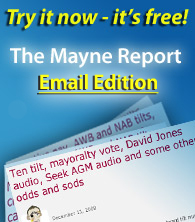WAN rorts, new video, alumina tilt, Rich List and AFIC
February 2, 2010
Dear Mayne Report recipients,
firstly, check out today's video naming the most Sackable Seven non-executive directors and you'll see a newly shaved skinhead in action.
It seems all my bleating last week about the no vacancy rort hasn't forced the board of West Australian Newspapers to change its position, but as you'll see from today's full edition, it has certainly highlighted what a scandal it is when used to the maximum potential.
The Australian's Bryan Frith and The AFR's Neil Shoebridge both picked up on the issue last Friday and, in a pointed demonstration of how bad WAN's tactics are, the Alumina board have just written to me advising they won't be using the no vacancy rort in my tilt at their upcoming AGM. Click through to see the full Alumina letter.
We've also got separate stories on the questionable proxy form WAN has produced, plus a story on Barclays being the kingmakers.
Our non-WAN coverage today includes a piece comparing Macquarie Fortress with the dramatic Carlyle collapse and we also look at AFIC's very unusual move of offering shareholders a chance to back out of its share purchase plan.
The markets are certainly in full meltdown mode now after the Bear Stearns bailout, but I'm stoically looking for value having picked up $500 worth of shares in Globe International, Adacel and Hansen Technologies. The portfolio is now more than $50,000 under water and you can see the full trading record here.
Elsewhere, we've added another 100-plus names to the Mayne Report Rich are now up to almost 750 entries.
Enjoy this beefy edition and do ya best, Stephen Mayne
* The Mayne Report is a multi-media governance website published by Stephen Mayne with occasional email editions. To unsubscribe from the emails click here.
firstly, check out today's video naming the most Sackable Seven non-executive directors and you'll see a newly shaved skinhead in action.
It seems all my bleating last week about the no vacancy rort hasn't forced the board of West Australian Newspapers to change its position, but as you'll see from today's full edition, it has certainly highlighted what a scandal it is when used to the maximum potential.
The Australian's Bryan Frith and The AFR's Neil Shoebridge both picked up on the issue last Friday and, in a pointed demonstration of how bad WAN's tactics are, the Alumina board have just written to me advising they won't be using the no vacancy rort in my tilt at their upcoming AGM. Click through to see the full Alumina letter.
We've also got separate stories on the questionable proxy form WAN has produced, plus a story on Barclays being the kingmakers.
Our non-WAN coverage today includes a piece comparing Macquarie Fortress with the dramatic Carlyle collapse and we also look at AFIC's very unusual move of offering shareholders a chance to back out of its share purchase plan.
The markets are certainly in full meltdown mode now after the Bear Stearns bailout, but I'm stoically looking for value having picked up $500 worth of shares in Globe International, Adacel and Hansen Technologies. The portfolio is now more than $50,000 under water and you can see the full trading record here.
Elsewhere, we've added another 100-plus names to the Mayne Report Rich are now up to almost 750 entries.
Enjoy this beefy edition and do ya best, Stephen Mayne
* The Mayne Report is a multi-media governance website published by Stephen Mayne with occasional email editions. To unsubscribe from the emails click here.
Barclays the key in WAN board fight
There has been a flurry of activity in the battle for West Australian Newspapers over the past 24 hours.
The board fired a pre-emptive shot yesterday by issuing a press release disclosing their planned suicide pact if even one of them gets rolled to make way for Kerry Stokes. Seven responded last night by pre-empting the formal ASX announcement and releasing all its arguments here on its campaign website.
At 11.30am today we finally got the formal 40-page notice of meeting from the WAN board and then they followed up with this 17-page presentation from chairman Peter Mansell and CEO Ken Steinke, along with their speeches at this afternoon's media and analysts briefing.
Seven fired back with this analysis, rejecting this conflict of interest argument and saying it only ever wanted two spots on an expanded seven person board, not all this garbage about takeovers without paying a premium.
The WAN board have pulled together some reasonable figures on the long term performance of the company. The tactic is definitely presenting shareholders with an "all or nothing" scenario.
It appears to be designed around the argument that WAN shareholders should force Seven to bid for the whole company. There are no halfway houses here. However, the suicide pact means Stokes will probably end up with a hand-picked board. I'm the only outside candidate that he's previously met, but he sat on the fence rather than supporting my candidacy at last year's AGM so it's unclear which of the 9 outsiders he will back.
On reading the documents, I'm contemplating a pitch to institutions calling for a full board room cleanout, on the proviso that Stokes agrees we need to add another three independent directors after the AGM, and probably have an independent chairman. I've no idea whether he'd want it, but Steve Harris would be perfect for the chairman's role given his vast experience in newspapers over 30 years.
The kingmakers here will be Barclays Global Investors which have 6%. If they back Stokes, the incumbents are finished.
Last week I emailed the Barclays executive who chairs the committee which makes voting decisions, requesting they take a stand on the no vacancy rort. Alas, the following came back from the Barclays spindoctor:
From: Pearce, Debbie BGI SYD
Sent: Friday, 14 March 2008 09:29
To: smayne@crikey.com.au
Subject: WA News
Importance: High
Hi Stephen
I am BGI's communications manager. I have been forwarded your email below by Monique Nugent in regard to WA News. Unfortunately we are unable to assist you in this instance as it is BGI's global policy not to publicly comment on specific company votes. Apologies that we cannot help you further.
Regards
Debbie Pearce
The board fired a pre-emptive shot yesterday by issuing a press release disclosing their planned suicide pact if even one of them gets rolled to make way for Kerry Stokes. Seven responded last night by pre-empting the formal ASX announcement and releasing all its arguments here on its campaign website.
At 11.30am today we finally got the formal 40-page notice of meeting from the WAN board and then they followed up with this 17-page presentation from chairman Peter Mansell and CEO Ken Steinke, along with their speeches at this afternoon's media and analysts briefing.
Seven fired back with this analysis, rejecting this conflict of interest argument and saying it only ever wanted two spots on an expanded seven person board, not all this garbage about takeovers without paying a premium.
The WAN board have pulled together some reasonable figures on the long term performance of the company. The tactic is definitely presenting shareholders with an "all or nothing" scenario.
It appears to be designed around the argument that WAN shareholders should force Seven to bid for the whole company. There are no halfway houses here. However, the suicide pact means Stokes will probably end up with a hand-picked board. I'm the only outside candidate that he's previously met, but he sat on the fence rather than supporting my candidacy at last year's AGM so it's unclear which of the 9 outsiders he will back.
On reading the documents, I'm contemplating a pitch to institutions calling for a full board room cleanout, on the proviso that Stokes agrees we need to add another three independent directors after the AGM, and probably have an independent chairman. I've no idea whether he'd want it, but Steve Harris would be perfect for the chairman's role given his vast experience in newspapers over 30 years.
The kingmakers here will be Barclays Global Investors which have 6%. If they back Stokes, the incumbents are finished.
Last week I emailed the Barclays executive who chairs the committee which makes voting decisions, requesting they take a stand on the no vacancy rort. Alas, the following came back from the Barclays spindoctor:
From: Pearce, Debbie BGI SYD
Sent: Friday, 14 March 2008 09:29
To: smayne@crikey.com.au
Subject: WA News
Importance: High
Hi Stephen
I am BGI's communications manager. I have been forwarded your email below by Monique Nugent in regard to WA News. Unfortunately we are unable to assist you in this instance as it is BGI's global policy not to publicly comment on specific company votes. Apologies that we cannot help you further.
Regards
Debbie Pearce
WA News and the no vacancy rort
The biggest single ruse in Australian corporate elections is "the no vacancy rort", whereby directors can determine the number of vacancies on a board after seeing who has nominated.
The great thing about the contested WA News board spill is that this particular group of incumbent directors have decided to exploit the rort to its maximum potential.
Faced with a specific request for board representation by its largest shareholder, the board have declared that this resolution will not even be put to the vote, unless the shareholders have first created a vacancy by sacking at least one of the incumbents.
This means that if the gang of four scrape back with 51% of the shares voted opposing their removal, none of the other 11 candidates will have their nominations considered, even if proxies were running 100% in favour of a candidate.
Given that the board are using the no vacancy rort to protect the editor of The West Australian, public enemy number one in the media for the ALP, I'm confident that this case study will be enough to get some legislative reform within 12 months.
All that needs to happen is for the Corporation Law or the ASX listing rules to stipulate that a public company constitution must prescribe a mimimum and maximum number of directors with the exact number at any point in time being a matter for shareholders.
The WAN constitution says nothing about a maximum of 5 directors. It prescribes a range of between 3 and 10, but then has the rort clause which allows the directors to pick any number they like to be the maximum at any point.
When I received my highest ever vote with 55% of the proxies in favour at the Woolworths AGM in 2000, the board promptly changed its constitution the following year to allow for the no vacancy rort. Lo and behold, my vote plunged to less than 3% at the 2006 Woolies AGM after the board was able to do the usual "sorry, there's no room in the inn for this chap".
The great thing about the contested WA News board spill is that this particular group of incumbent directors have decided to exploit the rort to its maximum potential.
Faced with a specific request for board representation by its largest shareholder, the board have declared that this resolution will not even be put to the vote, unless the shareholders have first created a vacancy by sacking at least one of the incumbents.
This means that if the gang of four scrape back with 51% of the shares voted opposing their removal, none of the other 11 candidates will have their nominations considered, even if proxies were running 100% in favour of a candidate.
Given that the board are using the no vacancy rort to protect the editor of The West Australian, public enemy number one in the media for the ALP, I'm confident that this case study will be enough to get some legislative reform within 12 months.
All that needs to happen is for the Corporation Law or the ASX listing rules to stipulate that a public company constitution must prescribe a mimimum and maximum number of directors with the exact number at any point in time being a matter for shareholders.
The WAN constitution says nothing about a maximum of 5 directors. It prescribes a range of between 3 and 10, but then has the rort clause which allows the directors to pick any number they like to be the maximum at any point.
When I received my highest ever vote with 55% of the proxies in favour at the Woolworths AGM in 2000, the board promptly changed its constitution the following year to allow for the no vacancy rort. Lo and behold, my vote plunged to less than 3% at the 2006 Woolies AGM after the board was able to do the usual "sorry, there's no room in the inn for this chap".
Alumina and WAN - a study in contrasts
The Alumina boys have shown the WA News board exactly how it should be done in relation to board vacancies. If the shareholders want me, it's a simply case of more for votes than against. However, it is WAN which is showing Alumina how to behave when it comes to accessing shareholder lists.
Mr S Mayne
PO Box 925 Templestowe 3106
Dear Mr Mayne
NOMINATION FOR ELECTION AS DIRECTOR FOR ALUMINA LIMITED
I refer to your and Ms P Piccinini's letters of 30 January 2008 in relation to the above and my email of 5 February 2008 in relation to nomination requirements.
I confirm that at the 2008 Annual General Meeting, there are three candidates for election (including yourself) and three vacancies. To be successfully elected as a Director at the 2008 Annual General Meeting, each candidate will need to receive more votes “for” than “against”.
The position on the Notice of Meeting and Proxy form are not been determined by ballot, but the order in which notifications for election were received. Your proposed platform has not been edited for the purposes of inclusion in the Notice of Meeting, and you will be given up to five minutes to address the meeting. It is the Company's practice that each director seeking election address the meeting.
In relation to access to a list of Alumina's top 200 beneficial shareholders, that information is maintained by Thomson Financial Services (“Thomson”). The information you have requested can be provided by Thomson within 21 days in hard copy form, on receipt of the prescribed fee of $450. Alternatively, you can inspect the information electronically at Thomson's offices in Sydney free of charge. Please advise which alternative you wish to pursue.
In relation to transcripts and audio files of earlier annual general meetings, beyond having an audio file of the most recent meeting, the company does not make these available.
Yours sincerely
STEPHEN FOSTER
COMPANY SECRETARY
Attempting to charge $450 to see the top 200 beneficial shareholders is disappointing. WA News has just emailed through their version a few minutes ago and there was no charge.
PO Box 925 Templestowe 3106
Dear Mr Mayne
NOMINATION FOR ELECTION AS DIRECTOR FOR ALUMINA LIMITED
I refer to your and Ms P Piccinini's letters of 30 January 2008 in relation to the above and my email of 5 February 2008 in relation to nomination requirements.
I confirm that at the 2008 Annual General Meeting, there are three candidates for election (including yourself) and three vacancies. To be successfully elected as a Director at the 2008 Annual General Meeting, each candidate will need to receive more votes “for” than “against”.
The position on the Notice of Meeting and Proxy form are not been determined by ballot, but the order in which notifications for election were received. Your proposed platform has not been edited for the purposes of inclusion in the Notice of Meeting, and you will be given up to five minutes to address the meeting. It is the Company's practice that each director seeking election address the meeting.
In relation to access to a list of Alumina's top 200 beneficial shareholders, that information is maintained by Thomson Financial Services (“Thomson”). The information you have requested can be provided by Thomson within 21 days in hard copy form, on receipt of the prescribed fee of $450. Alternatively, you can inspect the information electronically at Thomson's offices in Sydney free of charge. Please advise which alternative you wish to pursue.
In relation to transcripts and audio files of earlier annual general meetings, beyond having an audio file of the most recent meeting, the company does not make these available.
Yours sincerely
STEPHEN FOSTER
COMPANY SECRETARY
Attempting to charge $450 to see the top 200 beneficial shareholders is disappointing. WA News has just emailed through their version a few minutes ago and there was no charge.
Will WAN try to do a Nick Whitlam?
The proxy form that WAN has produced for the EGM deserves some close scrutiny. If a shareholder simply signs the form and sends its back, it looks like these votes will specifically default to the chairman, who will use them to entrench the four incumbents and vote against all 11 challengers.
Candidates have not been urged to vote on every resolution, so the chairman will inevitably pick up a huge chunk of undirected proxies, especially with the independent candidates. In a tight contest it could make all the difference.
Along with the "no vacancy rort", undirected proxies are the two great rorts of corporate elections. Undirected proxies usually average 6-10% of the total vote. A shareholder doesn't have to specifically nominate the chairman, this is the default option if they happen to not vote on a resolution or don't appoint an alternative proxy.
The most egregious example I've ever seen was when Nick Whitlam urged NRMA Insurance shareholders in 2000 to only vote in favour of 3 of the 4 candidates because there was insufficient vacancies.
Thousands of shareholders duly left my box empty and Whitlam scooped these up as undirected proxies, sending my "against" vote soaring from 73.2 million proxies to a massive 239.88 million after the poll. The "for" vote only rose from 60.5 million to 61.96 million, reducing a very healthy 44% primary vote down to 20.5%. You can see the figures for yourself here.
At least the WAN board haven't tried to limit how many candidates shareholders can actually vote in favour of, but the structure is there for both the no vacancy and undirected proxies rorts to play a major role in determining the outcome. This is all the more reason for an independent party to oversee the process and the conduct of the meeting.
Candidates have not been urged to vote on every resolution, so the chairman will inevitably pick up a huge chunk of undirected proxies, especially with the independent candidates. In a tight contest it could make all the difference.
Along with the "no vacancy rort", undirected proxies are the two great rorts of corporate elections. Undirected proxies usually average 6-10% of the total vote. A shareholder doesn't have to specifically nominate the chairman, this is the default option if they happen to not vote on a resolution or don't appoint an alternative proxy.
The most egregious example I've ever seen was when Nick Whitlam urged NRMA Insurance shareholders in 2000 to only vote in favour of 3 of the 4 candidates because there was insufficient vacancies.
Thousands of shareholders duly left my box empty and Whitlam scooped these up as undirected proxies, sending my "against" vote soaring from 73.2 million proxies to a massive 239.88 million after the poll. The "for" vote only rose from 60.5 million to 61.96 million, reducing a very healthy 44% primary vote down to 20.5%. You can see the figures for yourself here.
At least the WAN board haven't tried to limit how many candidates shareholders can actually vote in favour of, but the structure is there for both the no vacancy and undirected proxies rorts to play a major role in determining the outcome. This is all the more reason for an independent party to oversee the process and the conduct of the meeting.
Comparing Carlyle collapse with Macquarie Fortress
I'm still amazed at what little bad publicity Macquarie Group has suffered from the $250 million implosion of their three Macquarie Fortress funds.
The ASX-listed fund released its half year result on March 3 and it confirmed a $35 million loss, more margin calls and fire sales of loans. The units closed at 6c today, well off the original $1 issue price.
I gave Macquarie this spray for its Fortress fiasco in a special edition on February 15. Since then things have got a whole lot worse.
It is interesting to compare what has happened to legendary buyout firm Carlyle because it has just come a cropper on a fund which is very similar in structure to Macquarie Fortress - namely a hugely geared play on US loans which have been in free-fall recently.
The Carlyle partners pondered long and hard about personally bailing out the fund but then walked away when the margin calls started getting into the billions. Shareholders have just voted unanimously to put the fund into liquidation.
Sean Egan, of the Egan-Jones Ratings Company, said: “When financial history is written, the Carlyle liquidation will go down as one of the single most major events. Carlyle has built an image as one of the smartest investors around, and to see one of its funds fall apart shows there is a fundamental problem with the market.”
The same should apply to Macquarie. They are supposedly the smartest guys in the room, they have spectacularly come a cropper and, thus far, we have not had a single public utterance from any main board Macquarie director.
It looks like they are hoping to steer a middle course which avoids both bailouts and formal collapses. However, as an investor in Macquarie Fortress, I'm still yet to receive any explanation as to what has happened.
The ASX-listed fund released its half year result on March 3 and it confirmed a $35 million loss, more margin calls and fire sales of loans. The units closed at 6c today, well off the original $1 issue price.
I gave Macquarie this spray for its Fortress fiasco in a special edition on February 15. Since then things have got a whole lot worse.
It is interesting to compare what has happened to legendary buyout firm Carlyle because it has just come a cropper on a fund which is very similar in structure to Macquarie Fortress - namely a hugely geared play on US loans which have been in free-fall recently.
The Carlyle partners pondered long and hard about personally bailing out the fund but then walked away when the margin calls started getting into the billions. Shareholders have just voted unanimously to put the fund into liquidation.
Sean Egan, of the Egan-Jones Ratings Company, said: “When financial history is written, the Carlyle liquidation will go down as one of the single most major events. Carlyle has built an image as one of the smartest investors around, and to see one of its funds fall apart shows there is a fundamental problem with the market.”
The same should apply to Macquarie. They are supposedly the smartest guys in the room, they have spectacularly come a cropper and, thus far, we have not had a single public utterance from any main board Macquarie director.
It looks like they are hoping to steer a middle course which avoids both bailouts and formal collapses. However, as an investor in Macquarie Fortress, I'm still yet to receive any explanation as to what has happened.
AFIC offers refund on share purchase plan
Here's a novel move. Having banked plenty of cheques, the board of the $4.8 billion Australian Foundation Investment Company wrote to shareholders last week offering them a chance to withdraw their commitments to the current share purchase plan which is priced at $5.26.
AFIC closed today at $4.75, but the formal offer to buy up to $5000 worth of shares in the SPP was sent out on February 28 and was due to close on March 20.
To offer a get-out deal in the final week of a share purchase plan is highly unusual. Surely a contract is a contract and if you commit to take up the shares, you shouldn't be able to wriggle out of it.
AFIC also finds itself in a very interesting position in the WA News bunfight given its historical ties to JB Were, which floated the Perth-based company back in the early 1990s.
AFIC is Australia's biggest listed investment company also happens to be the third largest shareholder in WA News with a 3.87% stake. It has a history of supporting incumbent boards, especially those with a corporate relationship with JB Were.
However, Kerry Stokes also happens to be an important client of what is now Goldman-Sachs JB Were, although Goldman have apparently been retained for advise by the incumbent directors.
If AFIC had bothered to keep the cash committed by shareholders in the SPP, they could have taken advantage of market weakness to increase its stake in WAN.
Finally, here's a list of my SPP investment record over the past 15 months. In the case of AFIC's offer, I was following the normal prudent practice of leaving the decision until the final week.
AFIC closed today at $4.75, but the formal offer to buy up to $5000 worth of shares in the SPP was sent out on February 28 and was due to close on March 20.
To offer a get-out deal in the final week of a share purchase plan is highly unusual. Surely a contract is a contract and if you commit to take up the shares, you shouldn't be able to wriggle out of it.
AFIC also finds itself in a very interesting position in the WA News bunfight given its historical ties to JB Were, which floated the Perth-based company back in the early 1990s.
AFIC is Australia's biggest listed investment company also happens to be the third largest shareholder in WA News with a 3.87% stake. It has a history of supporting incumbent boards, especially those with a corporate relationship with JB Were.
However, Kerry Stokes also happens to be an important client of what is now Goldman-Sachs JB Were, although Goldman have apparently been retained for advise by the incumbent directors.
If AFIC had bothered to keep the cash committed by shareholders in the SPP, they could have taken advantage of market weakness to increase its stake in WAN.
Finally, here's a list of my SPP investment record over the past 15 months. In the case of AFIC's offer, I was following the normal prudent practice of leaving the decision until the final week.





















